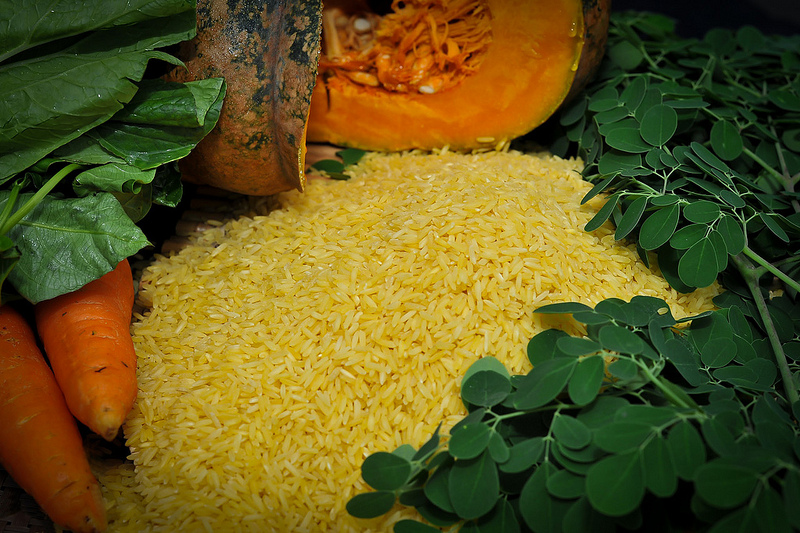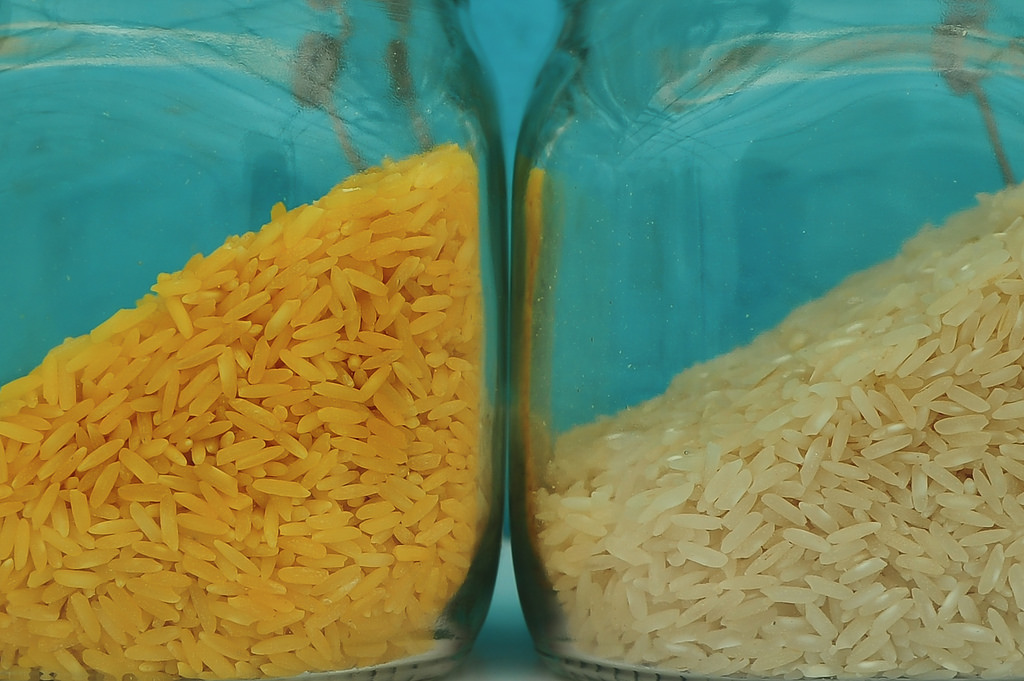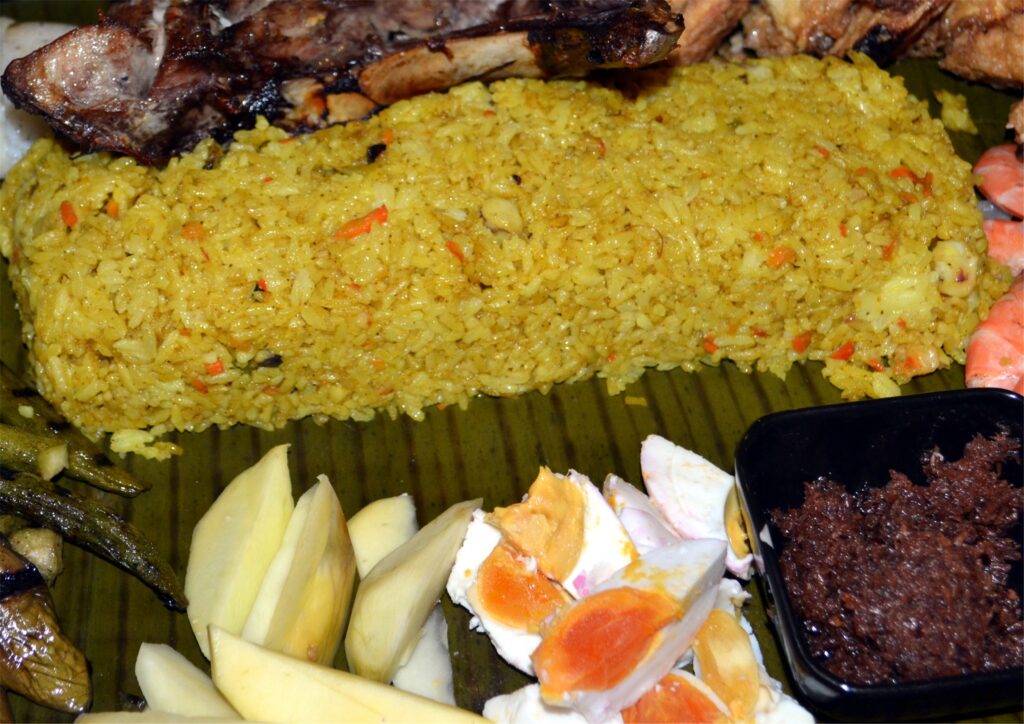By Henrylito D. Tacio
Photos courtesy of IRRI
If there’s a likely nutrient for good vision, a healthy immune system, and cell growth, it’s vitamin A. The fat-soluble vitamin also helps the heart, lungs, kidneys, and other organs work properly.
Actually, there are two types of vitamin A. The first type, called preformed vitamin A, is found in meat, poultry, fish, and dairy products. The second type, known as provitamin A, is found in fruits, vegetables, root crops, and other plant-based products.
The good news is: vitamin A can also be found in rice. And scientists who developed the crop called it golden rice. “(It) is a new type of rice that contains beta-carotene (provitamin A), which is converted into vitamin A as needed by the body and gives the grain its golden color,” explains the Laguna-based International Rice Research Institute (IRRI).
Normally, rice plants produce beta-carotene in their green parts, but not the grain that people eat. Golden rice is genetically engineered to produce beta-carotene in the edible part of the plant. Its beta-carotene gives the golden color to squash, papaya, and carrots.

Using genetic modification techniques, scientists developed golden rice using genes from corn and a common soil microorganism that produce beta-carotene in the rice grain.
Golden rice is intended to complement current strategies in the fight against vitamin A deficiency (VAD), according to IRRI. “It is intended to supply up to 30% to 50% of the estimated average requirement for vitamin A preschool age children and pregnant or lactating mothers,” it says.
VAD is a form of hidden hunger, a pervasive and persistent problem affecting more than two billion people worldwide. The Geneva-based World Health Organization (WHO) estimates some 190 million children and another 19 million pregnant women are directly affected by VAD globally.
“For children, lack of vitamin A causes several visual impairment and blindness, and significantly increases the risk of severe illness, and even death, from such common childhood infections as diarrheal disease and measles,” the United Nations health agency says.
VAD occurs for pregnant women in high-risk areas, especially during the last trimester when demand by both the unborn child and the mother is highest.
“We know vitamin A deficiency is a huge problem,” said Keith P. West, an American professor of infant and child nutrition at Johns Hopkins Bloomberg School of Public Health in Baltimore. “We know that some children are going to die who shouldn’t have died, because of this one nutrient.”

One recent study conducted by Tufts University in Boston came up with a conclusion that “if all children in deprived areas of the world were given enough vitamin A, up to 2.7 million deaths could be prevented each year.”
Filipinos are susceptible to VAD as rice is their staple food. Some studies show that 89% of Filipinos consume rice three times daily. That may seem bad news, but it can also be good news.
Although rice (known in the science world as Oryza sativa) is a complex carbohydrate, its protein contains all eight essential amino acids. It complements the amino acids found in many other foods. It is low in sodium, fat, and fiber, and it is easily digested.
Most of the rice available in the market is enriched, which means that it is also supplemented with iron, niacin, and thiamine besides its other assets. But most of these added nutrients are lost if rice is washed before cooking or drained afterward.
By putting beta-carotene in rice, Filipinos can have the much-needed vitamin A. “The beta-carotene produced in golden rice grain is identical to the beta-carotene in green leafy and many types of yellow-colored vegetables and orange-colored fruit, and identical to synthetic beta-carotene found in many vitamin supplements and food ingredients,” the IRRI says.
“I always say there are interventions like diversifying diet, breastfeeding, fortification and so on,” admitted Dr. Violeta Villegas, IRRI golden rice project coordinator. “They’re working but the fact remains that there’s still a sizable portion of our population not reached by these interventions.”

Studies reviewed and published in the American Journal of Clinical Nutrition found that golden rice is an effective vitamin A source for adults and children. Further research will be made to determine whether “daily consumption of golden rice does improve the vitamin A status of people who are vitamin A deficient and could therefore reduce related health conditions such as night blindness.”
One good thing about golden rice is that no company owns it. “Golden rice is being developed by a nonprofit group with the aim of providing a new source of vitamin A to people both in the Philippines, where most households get most of their calories from rice, and eventually in many other places in the world where rice is eaten every day by half the population,” wrote Amy Harmonaug in an article which appeared in The New York Times.
The men credited for discovering the golden rice were Ingo Potrykus, who was 65 at that time and was about to retire as a professor at the Swiss Federal Institute of Technology in Zurich, and Peter Beyer of the University of Freiburg. “My team targeted vitamin A deficiency because this is one of the largest health problems worldwide,” Prof. Potrykus was quoted as saying.
Golden rice has been bred with local rice cultivars in the Philippines and Taiwan and the American rice cultivar “Cocodrie.” The first field trials of these golden rice cultivars were conducted by Louisiana State University Agricultural Center in 2004. According to scientists, field testing provides a more accurate nutritional value measurement and enables feeding tests to be performed.
In the Philippines, the first-generation golden rice was first tested in advanced field trials in IRRI in 2008. The second generation of selected varieties was field-tested in the wet season of 2010. At the state-owned Philippine Rice Research Institute (PhilRice), confined field trials of advanced lines were conducted from February to June 2011.
“The field trials are an important step in evaluating the performance of golden rice and to determine if it can be planted, grown, and harvested just like other popular rice varieties,” PhilRice said in a statement. “These trials are also part of the safety assessment of golden rice.”
Last year, golden rice passed a rigorous biosafety assessment in the country. It was declared “as safe as conventional rice” by the Bureau of Plant Industry of the Department of Agriculture. “As soon as the necessary approvals are in place, golden rice can be made available to the public.”
Right now, golden rice is being prepared for deployment, just in case. “It has achieved the target levels of beta carotene, and has also been shown to produce equivalent yield to other varieties across multiple environs,” PhilRice says.
In the United States, the Food and Drug Authority wrote a letter stating that the concentration of beta carotene in golden rice “is too low to warrant a nutrient content claim.”
Contrary to the claim, golden rice is not insufficient in vitamin A content. On average, Americans eat only very little rice: about 45 grams per day. “It follows logic that American consumers would not benefit from golden rice as much as the average Filipino (who consumes 290 grams of rice daily),” PhilRice points out.
But because it’s genetically modified, golden rice has faced opposition from environmental groups and others. “A rip-off of the public trust” was how the Rural Advancement Foundation International, an advocacy group based in Winnipeg, Canada, said of the vitamin A-rich rice.
Vandana Shiva, an Indian anti-GMO (genetically modified organism) activist, argued the problem was not that the crop had any particular deficiencies but that there were potential problems with poverty and biodiversity loss in food crops. The corporate control of agriculture aggravates these problems via the control of genetically modified organisms.
By focusing on a narrow problem (vitamin A deficiency), Shiva argued, the golden rice proponents were obscuring the larger issue of a lack of broad availability of diverse and nutritionally adequate food sources.
On the contrary, both IRRI and PhilRice never claim that golden rice “will totally solve VAD.” In most of their issued statements, both have always emphasized that golden will serve as a complement – not a replacement – to current strategies to ease VAD, referring to supplementation, fortification, and eating diverse diets.
“When and where these (strategies) are not available, golden rice is an option, with the decision to plant or consume golden rice still left to each individual,” said a press statement.
Some groups also claim that golden rice will threaten food security by contaminating traditional rice varieties. “Golden rice is not likely to impact organic agriculture through cross pollination,” PhilRice assures.
According to PhilRice, cross-pollination in rice is rare if plants are separated by a short distance of a few meters. “Cross-pollination in rice is uncommon, unless all the rice plants are flowering at the same time,” it explains. “Rice pollen is normally viable for only a few minutes after flowering.”
In other words, organically-grown rice will not cross-pollinate naturally with other cultivated rice “unless they are growing close together and flowering at the same time.”
Dr. Siang Hee Tan, executive director of Singapore-based CropLife Asia, is totally disappointed with those against the commercialization of golden rice. “Make no mistake – this agricultural innovation is not a game-changer, it’s a life-changer,” he pointed out. “Golden rice has the potential to address critical Vitamin A deficiencies here in Asia and around the world.” – (Photos courtesy of IRRI)

